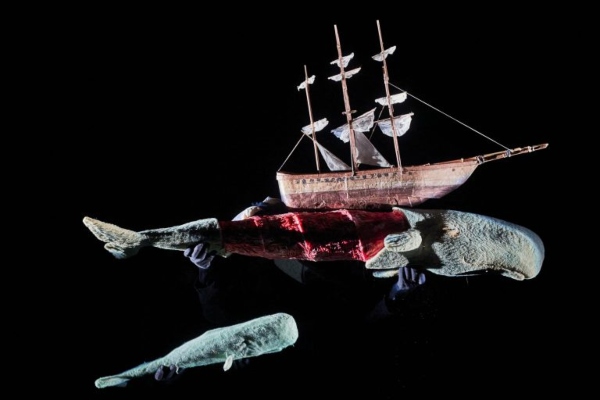Words by Eric Page
So here be monsters, on stage, in front of us, and what a visual feast Plexus Polaire, the French-Norwegian theatre company, has given us. Yngvild Aspeli is the creative director of this crew of more than 50 actors, puppeteer and musicians and technical crew. Together they weave a dark narrative of revenge, obsession, companionship, murderous industrial slaughter brutally inserted into the gentle life cycles of sperm whales.
This is Moby Dick brought to life. A visually stunning adaptation of Herman Melville‘s melancholy, strange beast of a book using video projections on smoke, a drowned orchestra, and a whale-sized whale. This is not just the tale of a fishing expedition, but also the story of a magnificent obsession and an irresistibly deep dive into the mysteries of life.

The visuals are lovely, opening with flashes of tiny fish whipping in a shoal through the huge whale bones, the water sparkling, we are immersed in this swirling light and shadows of the vast ocean deeps.
The puppeteers work the bodies of the crew, a few different sized Ahab’s let us feel the size of the obsessions of this monstrous man, the puppeteers delicate onstage presence erased by their black costumes and convincing organic movements of the crew, Ahab and the ocean life.
They bring the members of the crew convincingly to life, they drink, sing, argue, sleep. There are also moments that highlight the gay relationships and tenderness these men develop for each other, far from the prejudices of land. A sweet moment of flirting and intimacy is explored high up in the rigging between Ishmael and Queequeg. Later the sailors massage each others’ hands suggestively, plunged deep in a barrel of sperm oil.
(Moby-Dick is a pretty queer book, it has same-sex marriage: Ishmael, the narrator gets married in bed to Queequeg, the uber tattooed Pacific islander. I remember rereading the book a few times to make sure I’d understood what was being plainly written here. There is some evidence of Melville being gay)

We witness the wretched hunting and death of mother whale, her calf anxious, terrified, abandoned, as the men first murder then flench the blubber from her body. As the thick warm flesh is unwound from the huge body of the whale, the calf prods at the lifeless body and decapitated head searching for response. It’s unbearably touching, the women next to us crying as we watched. Such brutal times… The narrator tells us of the economic wealth confined in the skin and head of this majestic beast, slaughtered for profit.
The mutli-levelled video projections, both physically and metaphorically from Lejard-Ruffet’s of waves, stars and nautical maps, whale tails and ocean life, clouds and night skies are awesome.
The stage has two main levels, the upper level also feeling as if it’s a film screen, the action changing size, perspective, angle, lighting with such fluid grace that you need to keep reminding yourself that this is analogue, physical, people and puppets. It’s beguiling and seductive in the ways it quietly references other media and the way we choose to view things. I adored the quick changes of perspective, now bird’s eye view, now the thronging tang of being in the hold of the ship, now the whale’s eye view of the quiet rippling deeps.
The tone of the book is echoed with the crepuscular, shadowy, liminal projections and hangings from video designer David Lejard-Ruffet. Doom hangs over this stage. It’s palpable from the opening moment.

Ahab’s obsession drives the narrative, we see his sight of the whale, rage at it, howl at his own injuries, a hallucinogenic chasing of his own dismembered leg as he curses the whale. The whale in contrast to wild, scared, dishevelled Ahab is always graceful, soft, undulating, the various sized puppets moving with a liquid sinuous grace that evokes the muscular power of these huge aquatic creatures.
The music and soundscapes of voices, whale song, shanties, ocean birds and wind come from three live musicians with drums, double bass and electric guitar, giving us a kind of Clannad from the Abyss. I adored it.
We don’t ever get to see Ahab and Moby confront each other, or witness Ahab’s demented destruction at his own obsessive hands, lashed in ropes, taught and tangled up in the leviathan’s majestic body as it furiously plunges into the depths. The ending fades to grey instead, our sole survivor of the final disastrous encounter with the great white whale, Ishmael telling us of what happened. An interesting choice but one which suits this carefully low key, but emotionally impactive, utterly engaging piece of refined stage craft. This feels more like witness than audience, transporting, haunting, convincing.
We do get to see Moby Dick one last time, and He sees us: with a simply brilliant piece of sassy stage craft that lets us watch a full-sized albino sperm whale swim slowly past the stage. Its baleful eye looking out at us, judging us puny, undeserving of further attention. It made me smile with the sheer audacity of its simplicity. Delightful moment in a 90 minute no interval evening of beautiful, certain cetacean suspended belief. ‘Let faith oust fact; let fancy oust memory; I look deep down and do believe.”
Seriously impressive, a wonderful evocative show, and worth experiencing if you can get a ticket.
Moby Dick is at Theatre Royal till May 27.
For more info or to buy tickets see the Brighton Festival Website here


















You must be logged in to post a comment.